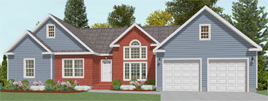CALL 888-764-1297
Magnificently Built Modular Homes
 In New York and New Jersey, builders are stacking together prebuilt modules made out of state, as they piece together towns and cities with homes that are built almost entirely offsite.
In New York and New Jersey, builders are stacking together prebuilt modules made out of state, as they piece together towns and cities with homes that are built almost entirely offsite.
Prefabricated construction, or modular construction, is constructing a home or building away from its ultimate location. Developers and architects increasingly look to the technique as a way to save time and money.
Modular construction can take 2 months from start to finish, down from several months to a year for traditional construction.
Modular construction is less expensive and faster than site built construction and doesn’t drag down the quality of the finished work. In fact, in many cases, the quality is better than traditional construction.
There are savings in time, savings in money. There are advantages by just condensing the entire construction process.
A crane is used to lift a sizeable module onto the top of the stack, once that is completed, installation onsite, the buttoning up and finish work is done onsite.
The technique is not new. There’s a budding renaissance in modular construction or offsite construction.
The renaissance is starting with an awareness that modular homes can be built with an imagination, and it can be done with a thoughtful design, and it can produce a custom designed product.
A May 2011 McGraw-Hill Construction report found that prefab building is emerging once again as a U.S. trend, tied partly to the popularity of "green" buildings and digital modeling.
After surveying hundreds of industry professionals, researchers found that the real estate industry is increasingly moving toward modular to boost productivity and cut waste.
Digital modeling allows you to see how prefab pieces fit together, allowing better advance planning, while reduced waste and better safety for workers are also factors.
All of these things combined with an economy that put pressure on the industry means that they’ve looked for efficiencies. Prefab has been around forever, but the next evolution of prefab has been in the last three or four years.
Cheaper labor in a controlled factory environment, where there’s less safety risk, is part of the appeal.
When you start to look at some of the real benefits, in terms of shorter schedules, lower costs and less waste, all of sizeable percentages, it just makes good bottom-line business sense.
For information on modular construction, contact Avalon Building Systems.
ibtimes
HOME | COMMERCIAL | RESIDENTIAL | MODULAR BENEFITS | FLOOR PLANS | GALLERY | FINANCIAL INFO | TESTIMONIALS | ABOUT | CONTACT | BLOG | SITE MAP